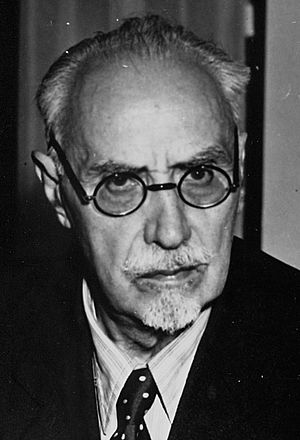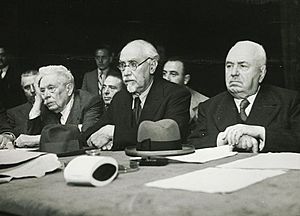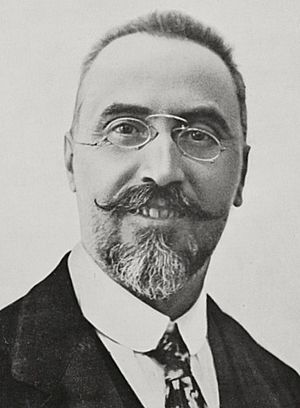Ivanoe Bonomi facts for kids
Quick facts for kids
Ivanoe Bonomi
|
|
|---|---|
 |
|
| President of the Senate | |
| In office 8 May 1948 – 20 April 1951 |
|
| Preceded by | Pietro Tomasi Della Torretta |
| Succeeded by | Enrico De Nicola |
| Prime Minister of Italy | |
| In office 18 June 1944 – 21 June 1945 |
|
| Monarch | Victor Emmanuel III |
| Lieutenant General | The Prince of Piedmont |
| Deputy | Palmiro Togliatti Giulio Rodinò |
| Preceded by | Pietro Badoglio |
| Succeeded by | Ferruccio Parri |
| In office 4 July 1921 – 26 February 1922 |
|
| Monarch | Victor Emmanuel III |
| Preceded by | Giovanni Giolitti |
| Succeeded by | Luigi Facta |
| Personal details | |
| Born | 18 October 1873 Mantua, Lombardy, Kingdom of Italy |
| Died | 20 April 1951 (aged 77) Rome, Latium, Italy |
| Political party | PSI (1893–1912) PSRI (1912–1922) PDL (1943–1948) PSDI (1948–1951) |
Ivanoe Bonomi (born October 18, 1873 – died April 20, 1951) was an important Italian politician and journalist. He served as Prime Minister of Italy two times: first from 1921 to 1922, and then again from 1944 to 1945. He played a key role in Italy's history, especially during the difficult times of World War I and World War II.
Contents
Early Life and Education
Ivanoe Bonomi was born in Mantua, Italy. His family was well-off. He studied natural sciences at the University of Bologna and finished his degree in 1896. After teaching high school for two years, he also earned a law degree from the same university.
Joining the Socialist Movement
In 1893, Bonomi became interested in the growing movement for cooperation and social change. He joined the Italian Socialist Party. He believed in making gradual changes to society, rather than sudden, big revolutions. He thought that different social groups should work together to protect democracy.
Bonomi believed Italy needed to become a modern democracy before it could move towards socialism. He supported creating voluntary cooperatives for farmers. He also supported other reformist leaders in Europe.
Early Political Career
In 1907, Bonomi was elected to the city council of Rome. In 1909, he became a member of the Italian Parliament for Mantua. He strongly supported Giovanni Giolitti, a liberal leader, believing this would help socialists influence important changes like allowing all men to vote.
However, Bonomi's moderate views were often different from the main ideas of the Socialist Party. In 1911, he even showed some support for Italy's invasion of Libya. In 1912, he and other moderate socialists were expelled from the party. They then formed the Italian Reformist Socialist Party.
World War I and Government Roles
Bonomi's new party supported Italy joining World War I. When Italy declared war in May 1915, Bonomi joined the army as a sub-lieutenant and fought on the front lines.
In June 1916, he became the Minister of Public Works. He held this job for a year. He served in the same role again from January to June 1919. After the war, he was the Minister of War from 1920 to 1921. He also briefly served as Minister of the Treasury.
First Time as Prime Minister
A few months later, in 1921, Ivanoe Bonomi became Prime Minister of Italy for the first time. He led a government made up of several parties. He was the first socialist to hold this important position.
His government faced many challenges. In early 1922, his government collapsed. He was replaced by Luigi Facta. This happened as the Fascist movement, led by Benito Mussolini, was gaining power in Italy.
During the Fascist Era
After the Fascist regime took control, Bonomi stepped away from politics. He spent these years studying history. He wrote about important Italian figures like Giuseppe Mazzini and the 1849 Roman Republic. He also worked on a history of Italian politics from 1870 to 1918.
Towards the end of 1942, as Italy was struggling in World War II, Bonomi secretly began meeting with people who opposed Fascism. He also started an underground newspaper called la Ricostruzione.
In June 1943, he met privately with King Victor Emmanuel III. Bonomi suggested that Mussolini should be removed from power and that Italy should end its alliance with Nazi Germany. The King did not act on this idea right away. Bonomi continued to push for Mussolini's removal and for Italy to leave the war.
Fall of Fascism and Second Term as Prime Minister
After the Fascist government fell in July 1943, Bonomi attended meetings with other anti-fascist leaders. They asked the new government to get rid of Fascist groups, free political prisoners, and allow free newspapers again.
On September 9, 1943, after Italy announced it was leaving the war, six anti-fascist parties formed the National Liberation Committee (CLN). Bonomi was chosen to lead this group. The CLN played a big role in the Italian resistance movement against the German occupation. While Rome was under German control, Bonomi hid under the protection of Pope Pius XII.
As president of the CLN, Bonomi tried to keep the focus on fighting the Germans and restoring democracy, rather than immediately changing Italy's government from a monarchy to a republic. He worked to bring together different political groups.
On June 8, 1944, two days after Rome was freed, Bonomi became Prime Minister again. His government first met in Salerno and then moved to Rome. Bonomi also served as Minister of the Interior and Minister of Foreign Affairs.

His main goals were to continue the war until Italy was fully free from German occupation. He officially recognized the partisan fighters in the North as part of the war effort. He also approved a plan for Italy to elect a Constituent Assembly after the war. This assembly would write a new constitution for Italy.
Bonomi resigned in November 1944 due to disagreements, but he was re-appointed as Prime Minister soon after. In the final months of the war, he approved plans for a referendum on whether Italy should be a monarchy or a republic, and for general elections. He also made reforms to social security, helping people with lower pensions.
After the war ended in Europe, Bonomi faced more criticism. He resigned on June 21, 1945.
Later Life
In June 1946, Bonomi was elected to the Constituent Assembly. He led the committee that worked on the peace treaty with the Allies. He also attended the peace treaty conference in Paris.
In 1948, he became a member of the Italian Senate. He was elected as its president, becoming the first president of the Senate after Italy became a Republic. He held this position until his death. He joined the new Italian Socialist Workers' Party.
Ivanoe Bonomi died on April 20, 1951, at the age of 77, in his official residence in Rome.
See also
 In Spanish: Ivanoe Bonomi para niños
In Spanish: Ivanoe Bonomi para niños


